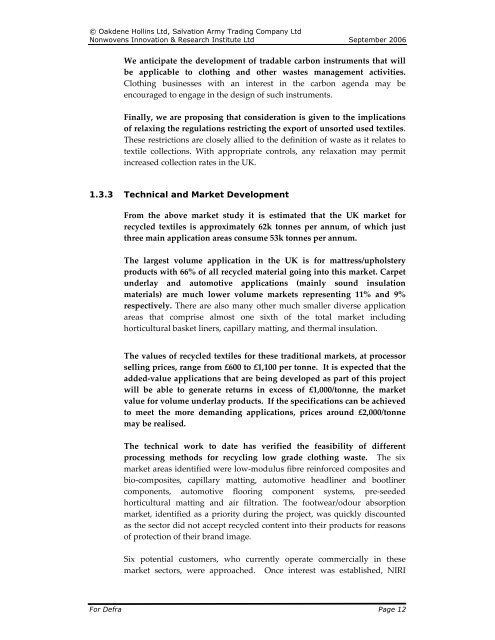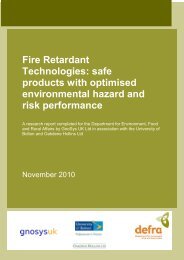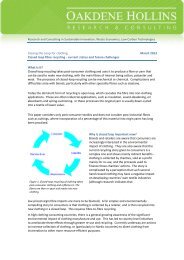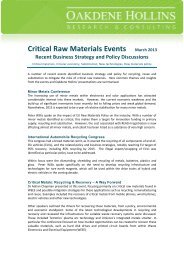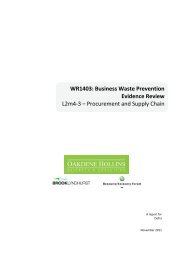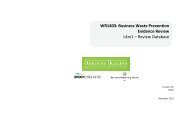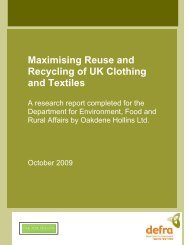Recycling of Low Grade Clothing Waste - Oakdene Hollins
Recycling of Low Grade Clothing Waste - Oakdene Hollins
Recycling of Low Grade Clothing Waste - Oakdene Hollins
Create successful ePaper yourself
Turn your PDF publications into a flip-book with our unique Google optimized e-Paper software.
© <strong>Oakdene</strong> <strong>Hollins</strong> Ltd, Salvation Army Trading Company Ltd<br />
Nonwovens Innovation & Research Institute Ltd September 2006<br />
We anticipate the development <strong>of</strong> tradable carbon instruments that will<br />
be applicable to clothing and other wastes management activities.<br />
<strong>Clothing</strong> businesses with an interest in the carbon agenda may be<br />
encouraged to engage in the design <strong>of</strong> such instruments.<br />
Finally, we are proposing that consideration is given to the implications<br />
<strong>of</strong> relaxing the regulations restricting the export <strong>of</strong> unsorted used textiles.<br />
These restrictions are closely allied to the definition <strong>of</strong> waste as it relates to<br />
textile collections. With appropriate controls, any relaxation may permit<br />
increased collection rates in the UK.<br />
1.3.3 Technical and Market Development<br />
From the above market study it is estimated that the UK market for<br />
recycled textiles is approximately 62k tonnes per annum, <strong>of</strong> which just<br />
three main application areas consume 53k tonnes per annum.<br />
The largest volume application in the UK is for mattress/upholstery<br />
products with 66% <strong>of</strong> all recycled material going into this market. Carpet<br />
underlay and automotive applications (mainly sound insulation<br />
materials) are much lower volume markets representing 11% and 9%<br />
respectively. There are also many other much smaller diverse application<br />
areas that comprise almost one sixth <strong>of</strong> the total market including<br />
horticultural basket liners, capillary matting, and thermal insulation.<br />
The values <strong>of</strong> recycled textiles for these traditional markets, at processor<br />
selling prices, range from £600 to £1,100 per tonne. It is expected that the<br />
added‐value applications that are being developed as part <strong>of</strong> this project<br />
will be able to generate returns in excess <strong>of</strong> £1,000/tonne, the market<br />
value for volume underlay products. If the specifications can be achieved<br />
to meet the more demanding applications, prices around £2,000/tonne<br />
may be realised.<br />
The technical work to date has verified the feasibility <strong>of</strong> different<br />
processing methods for recycling low grade clothing waste. The six<br />
market areas identified were low‐modulus fibre reinforced composites and<br />
bio‐composites, capillary matting, automotive headliner and bootliner<br />
components, automotive flooring component systems, pre‐seeded<br />
horticultural matting and air filtration. The footwear/odour absorption<br />
market, identified as a priority during the project, was quickly discounted<br />
as the sector did not accept recycled content into their products for reasons<br />
<strong>of</strong> protection <strong>of</strong> their brand image.<br />
Six potential customers, who currently operate commercially in these<br />
market sectors, were approached. Once interest was established, NIRI<br />
For Defra Page 12


